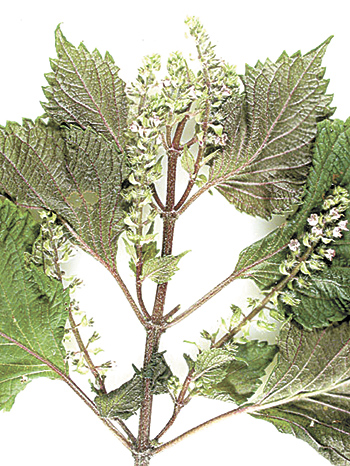 Following a suspected case of livestock poisoning in Kings Mountain, NC, local livestock producers are encouraged to examine their pastures, hayfields, and barnyards for Perilla Mint.
Classification and Description
Perilla mint is a member of the Lamiaceae or mint family. It is an erect, herbaceous annual that can grow to heights of 2 feet. The leaves are simple, opposite and can be purple or green tinged with purple, making it an attractive plant. Leaves have coarsely serrated (toothed) leaf margins pointed toward the tip and can be up to 5 inches wide and 7 inches long. Leaves are egg-shaped, with the largest part nearest the base. The stems of perilla mint are square in cross section, erect, hairy, somewhat branched and green or purple. Many small, white to purplish-white flowers with a ring of hairs in the throat are clustered in the terminals of these plants. Reproduction is by seed. Perilla mint has a shallow taproot and fibrous roots.
Weed Status and Injury
Perilla mint causes more cattle deaths in Tennessee than any other toxic plant. It is currently becoming established in Western NC pastures. Perilla is very poisonous to cattle and other ruminants, as well as horses. All plant parts are toxic, especially the flowering structures. Dried plants in hay can be toxic, but the greatest risk is associated with consumption of fresh plant material, especially if flowers and fruit are present. Perilla mint contains ketones that cause acute respiratory distress syndrome in cattle (ARDS), also called panting disease. Treatment is often ineffective. Although these plants can occur anywhere in a pasture or feed lot, they typically favor semi-shaded environments, and are most frequently located around farm structures, edges of woods and along fence rows. Cases of poisoning from these weeds are a concern during the late summer and early fall when other grasses and forages might be in short supply and the perilla mint is flowering. Animals will normally not feed on these toxic weeds unless there is a shortage of other feed. Therefore, it is crucial to have a ready supply of quality feed available for farm animals during this time of the year.
Management Considerations
Control of perilla mint in pastures, barn lots and forage fields is very important. If you find it growing on your farm, you can take these steps to ensure that your livestock and horses are safe:
The best time to scout for and control perilla mint is late April to early June, while it is young and actively growing. During that time, you can get good control using 2,4-D, Weedmaster, Grazon P+D, and Remedy Ultra.
Perilla mint is very difficult to control in late summer and early fall when it also becomes the most dangerous to livestock. During these periods, it can be mowed closely to reduce exposure risk and prevent seed formation will help prevent further spread.
If control measures are not taken early, it becomes even more crucial in late summer to maintain an adequate supply of quality feed for farm animals so they will not feed on these toxic weeds.
Grazing in infested pastures should be limited during late summer when perilla mint is flowering.
Avoid harvesting hay in areas infested with these weeds.
For complete information contact your Cleveland County Cooperative Extension Agents at 704-482-4365.
Provided by Cleveland County Cooperative Extension |





